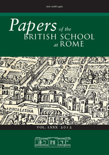
Papers of the British School at Rome
Scope & Guideline
Elevating Academic Discourse on Rome's Timeless Influence
Introduction
Aims and Scopes
- Roman Archaeology:
The journal emphasizes archaeological research, presenting findings from excavations and fieldwork that shed light on ancient Roman sites, structures, and artifacts. - Cultural and Historical Studies:
It explores the cultural, social, and political contexts of Rome, including studies on historical figures, events, and the evolution of urban and rural landscapes. - Art and Aesthetics:
Research on artistic expressions from antiquity to modern times is a core focus, examining how art informs our understanding of Roman identity and its legacy. - Interdisciplinary Approaches:
The journal encourages interdisciplinary methodologies, integrating insights from literature, anthropology, and postcolonial studies to enhance the understanding of Roman history. - Postcolonial Perspectives:
Recent themes reflect a growing interest in postcolonial studies, exploring the legacies of Roman imperialism and their contemporary implications.
Trending and Emerging
- Environmental Archaeology:
Recent publications increasingly focus on environmental aspects of Roman life, such as urban infrastructure and its ecological impacts, reflecting a growing interest in sustainability and historical ecology. - Cultural Heritage and Museum Studies:
There is a notable uptick in papers addressing the role of cultural heritage in contemporary society, including discussions on museum practices, conservation, and the interpretation of artifacts. - Postcolonial and Global Perspectives:
Emerging themes delve into the postcolonial implications of Roman history, examining how imperial legacies affect modern identities and cultural practices. - Digital Humanities:
The journal is embracing technological advancements, with more studies utilizing digital tools for data analysis, visualization, and the dissemination of research findings. - Social History and Everyday Life:
A trend towards examining the everyday experiences of individuals in ancient Rome is becoming more prominent, emphasizing social dynamics and cultural practices beyond elite narratives.
Declining or Waning
- Medieval Studies:
There has been a noticeable decrease in papers specifically addressing medieval Roman topics, suggesting a shift towards more classical and contemporary studies. - Traditional Antiquarian Studies:
The journal has seen fewer contributions focusing on antiquarian networks and the historical collection of artifacts, as interest moves towards modern interpretations and contexts. - Narrow Geographical Focus:
Research that concentrates solely on specific, less significant Roman locations has declined, with a broader emphasis now on major sites and their broader implications. - Static Historical Narratives:
There appears to be a reduction in studies that merely recount historical events without engaging with contemporary relevance or interdisciplinary connections.
Similar Journals
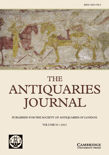
Antiquaries Journal
Exploring the Depths of Antiquity.The Antiquaries Journal, published by Cambridge University Press, is a prestigious publication dedicated to the multidisciplinary exploration of antiquarian studies, archaeology, history, and the visual arts. With an impact factor reflective of its influence within the academic community, it is essential reading for researchers, professionals, and students alike. This journal serves as a vital platform for disseminating cutting-edge research and scholarly discourse, particularly in its recent categorization within Q1 in Visual Arts and Performing Arts and Q2 in History. The journal spans a rich historical timeline from 1921 to the present, offering unique insights and fostering dialogue in the interrelated fields of archaeology and historical inquiry. While it is not an open-access journal, its commitment to rigorous peer review and academic excellence ensures that the content remains a critical resource for anyone engaged in the study of the past, particularly within the United Kingdom and beyond.

Romische Quartalschrift fur Christliche Altertumskunde und Kirchengeschichte
Unveiling the Rich Tapestry of Christian History.Romische Quartalschrift fur Christliche Altertumskunde und Kirchengeschichte is a prestigious academic journal published by VERLAG HERDER GMBH that focuses on the intricate fields of Christian antiquity and church history. With its origins steeped in rigorous scholarly tradition, this journal provides a critical platform for researchers, professionals, and students to share their findings and insights, fostering a deeper understanding of the historical and cultural contexts of Christianity. Despite its discontinuation in Scopus from 2002 to 2014, it continues to be a vital resource for those engaged in religious studies, history, and archaeology, as evidenced by its rankings in the relevant categories. Although it does not offer Open Access options, the journal's contributions to the academic community remain significant and informative, encouraging rich dialogue and exploration among scholars in these disciplines. Located at Hermann-Herder-Str 4, Freiburg im Breisgau 79104, Germany, the journal invites submissions that ensure a continuous discourse on the impacts of Christian heritage and its intersections with various domains of historical inquiry.
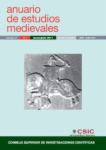
Anuario de Estudios Medievales
Advancing Knowledge in the Realm of the Middle AgesAnuario de Estudios Medievales is an esteemed academic journal dedicated to the field of Medieval Studies, published by the Consejo Superior de Investigaciones Científicas (CSIC) in Spain. With an ISSN of 0066-5061 and an E-ISSN of 1988-4230, the journal has been offering open access to researchers since 1996, fostering a collaborative and inclusive scholarly environment. Recognized for its high impact, it holds a commendable Q1 ranking in History as of 2023, reflecting its influence in the academic community. The journal encompasses a rich array of topics within medieval history, making it a vital resource for historians, scholars, and students alike who seek to explore and understand the complexities of the medieval period. With its indexed presence in Scopus, where it ranks 557th among 1760 in the Arts and Humanities category, Anuario de Estudios Medievales stands as a cornerstone publication, bridging historical inquiry and contemporary research in Medieval Studies.
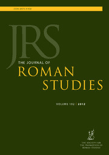
JOURNAL OF ROMAN STUDIES
Fostering Insights into the Roman ExperienceThe JOURNAL OF ROMAN STUDIES, published by Cambridge University Press, is a prestigious academic journal dedicated to the exploration of the Roman world through archaeological, historical, and literary lenses. With a rich publication history dating back to 1911, this journal has established itself as a leading platform for groundbreaking research in the fields of Classics, History, and Visual Arts, holding Q1 rankings in multiple categories as of 2023. Scholars from around the globe rely on its rigorous peer-reviewed articles to inform their work and advance the understanding of Roman culture and society. Although it operates under a traditional access model, the journal's impact factor and broad bibliographic reach ensure that it remains an invaluable resource for researchers, students, and professionals alike. With its continued commitment to excellence, the JOURNAL OF ROMAN STUDIES not only contributes to academic discourse but also invites new insights into the timeless relevance of Roman studies.

Cuadernos de Estudios Gallegos
Charting New Terrains in Galician ResearchCuadernos de Estudios Gallegos is a prestigious academic journal dedicated to the interdisciplinary study of Galician culture and history, published by the CONSEJO SUPERIOR INVESTIGACIONES CIENTIFICAS-CSIC. Since its inception in 1967 and transitioning to an Open Access model in 1991, this journal has become a crucial platform for researchers and scholars seeking to explore the rich historical and cultural tapestry of Galicia, Spain. With an ISSN of 0210-847X and an E-ISSN of 1988-8333, Cuadernos de Estudios Gallegos is indexed in reputable databases, achieving an impressive rank of #664 out of 1760 in the Arts and Humanities History category, placing it in the 62nd percentile for scholarly impact. The journal provides a diverse range of scholarly articles, fostering discussions that enhance understanding of regional history within broader historical contexts. As it strives to contribute to the academic community's knowledge, it particularly invites contributions from both emerging voices and established scholars, making it an essential resource for anyone passionate about the study of Galician heritage.
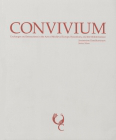
Convivium-Exchanges and Interactions in the Arts of Medieval Europe Byzantium and the Mediterranean
Unveiling Cultural Connections Across Time and SpaceConvivium - Exchanges and Interactions in the Arts of Medieval Europe Byzantium and the Mediterranean, published by Masarykova University, is a dedicated platform for scholarly discourse in the fields of Classics, History, and the Visual Arts and Performing Arts. Since its inception in 2017, this journal has aimed to enrich our understanding of the intricate cultural interconnections between medieval Europe, Byzantium, and the Mediterranean region, standing as an important resource for researchers, professionals, and students alike. While the journal is published in an open-access format, enabling wider dissemination of knowledge, it currently holds a respectable Q3 quartile ranking across its categories in 2023, reflecting its increasing reputation in the academic community. Although the journal is based in Belgium, its scholarly reach is truly international, as evidenced by its varied contributions. Engage with Convivium to explore the rich tapestry of medieval art and thought, and contribute to the ongoing dialogue about our shared cultural heritage.
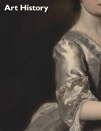
ART HISTORY
Celebrating the Diversity of Artistic Expression Through the AgesART HISTORY is a prestigious journal published by Wiley, focusing on the dynamic and diverse field of visual arts and performing arts since its inception in 1978. With an ISSN of 0141-6790 and an E-ISSN of 1467-8365, the journal has established itself as a significant resource for researchers, professionals, and students interested in exploring the complexities of art across various epochs and cultures. Currently ranked in the Q3 category within the Visual Arts and Performing Arts sector and positioned at #132 out of 667 in Scopus rankings—representing the top 80th percentile—ART HISTORY delivers insightful scholarship that contributes to the understanding and appreciation of art history. Although it does not offer open access, the journal remains committed to publishing high-quality, peer-reviewed articles that delve into critical artistic practices, theories, and aesthetics. The journal's location in the United Kingdom further enhances its international reach and influence, making it a vital platform for advancing discourse in the arts.

Lanx-Journal of the Scuola di Specializzazione in Archeologia of the University of Milan
Exploring cultural heritage through innovative research.Lanx-Journal of the Scuola di Specializzazione in Archeologia of the University of Milan, published by Milano University Press, is a distinguished platform dedicated to the field of archaeology. Committed to advancing archaeological research and scholarship, this Open Access journal has been available to the global academic community since 2008, facilitating easy dissemination of innovative ideas and findings. With a strong emphasis on promoting interdisciplinary dialogue, the journal covers a wide range of topics from classical archaeology to contemporary practices, making it an invaluable resource for researchers, professionals, and students in the field. Situated in the historic city of Milan, it aims to contribute to the preservation and understanding of cultural heritage through rigorous academic inquiry and collaboration.

Anatolian Studies
Exploring the Depths of Anatolian HeritageAnatolian Studies, published by Cambridge University Press, stands as a premier forum for research in the fields of archaeology, cultural studies, and history. Established in 1951, this esteemed journal has consistently contributed to the academic discourse surrounding the rich and multifaceted history of Anatolia, earning its place in the Q1 category across multiple disciplines. With a notable impact factor reflected in its Scopus rankings, it ranks among the top journals in its fields: 78th in History, 155th in Cultural Studies, and 55th in Archaeology, showcasing its significant influence and recognition. This journal serves as an invaluable resource for researchers and scholars seeking to delve into the intricacies of Anatolian heritage, providing a platform for innovative research and critical discussion within the academic community. While it currently does not offer open access, Anatolian Studies continues to enrich scholarly resources and advance knowledge within its key areas of focus.

Archaeological Reports-London
Unearthing the Past, Shaping the FutureArchaeological Reports-London, published by Cambridge University Press, is a prominent journal dedicated to advancing the field of archaeology, encompassing a comprehensive range of studies that delve into the rich tapestry of human history from prehistory to modern times. With an ISSN of 0570-6084 and an E-ISSN of 2041-4102, this journal has been a significant source of scholarly articles since its inception in 1955, serving as a crucial platform for researchers and academics alike. The journal is categorized in the third quartile for Archaeology and Arts and Humanities, and holds a prestigious position in the first quartile for Classics, reflecting its vital role in the scholarly community. With its esteemed ranking of Rank #45/170 in Classics and Rank #210/413 in Archaeology, it provides unparalleled insights and findings that shape contemporary archaeological discourse. Although not an open-access publication, the journal remains key for those who seek to enrich their understanding of archaeological practices and heritage conservation. Engage with Archaeological Reports-London to explore cutting-edge research that illuminates our understanding of past civilizations and informs future directions in the field.